Houghton, Samuel (McKechnie Section 4)
See also Houghton and Bruce, and Section Five
Recorded by Coke (Confessions of an Incurable Collector). Houghton worked in Edinburgh; since he gives no address on his trade label, he may have been an itinerant artist based on the city, but there is no evidence that he travelled outside Scotland. The only directory references (Edinburgh and Leith Post Office Directories) list Houghton jointly with his pupil George Bruce, giving the addresses (first) 31 South Bridge Street and (second) 'Head of Anchor Close'; their partnership (see Houghton and Bruce) probably began c. 1792 and ended with Houghton's death in 1796. Lacking any information from directories or from the artist's trade label, we do not know from any other source where Houghton lived and worked in Edinburgh before the period of his partnership with Bruce. Only one address has been seen, pencilled on the back of Houghton's profile of General Tarleton (in the J. A. Pollak collection).
This is 4 Brunswick Street, which Houghton may have occupied c. 1786.
1254
In Section Five I suggest that Houghton's first silhouettes (dating perhaps from as early as 1783) were painted on ivory. The style of his work on plaster indicates that none was executed until after c. 1786, the year during which John Miers arrived in Edinburgh. It seems likely that John Miers's work gave Houghton the incentive to paint profiles on plaster, but it seems unlikely that, after Miers's experience at the hands of Mary Lightfoot (q.v.), he would be willing to give lessons to yet another potential rival. Houghton appears to have produced independent work on ivory from c. 1783 until the beginning of his partnership with Bruce (previously his pupil) in c. 1792. Four examples of Houghton's work were sold by Sotheby and Company, London, at the Desmond Coke sale in July 1931.
I should like to discuss Houghton's work by noting how it differs from that of John Miers (see also the magnification photographs, which illustrate details of profiles by both artists, in this Section). Both artists worked on ivory and plaster, and the same differences are apparent in their work on both surfaces, although more markedly on their profiles on plaster.
How much Houghton's technique as a painter on plaster was influenced by Miers is difficult to say. Shadows beneath pigtail ribbons, giving depth to the portrait, were a feature of much of the work produced by Miers in Edinburgh, and are certainly visible on one of the illustrated examples of Houghton's work. Houghton's method of painting frills is more elaborate than that of Miers during his Edinburgh period, though simpler than that adopted by Miers after he settled in London. Such details as the ends of women's hair, which Miers rendered by fine brushwork, Houghton rendered by smudging.
The bust-line on Houghton's work does not finish in the extremely sharp point which is characteristic of Miers's work; the forepart of the line plunges deeper (though less deeply than that seen on Bruce's work). Miers's profiles painted in Edinburgh (most of which bear Trade Label No. 8) show a more nearly vertical line at the back, even when this is partly concealed by an à la conseilleur hair-style; on Houghton's work, this line tends either to be curved or to slope outwards.
Houghton's silhouettes on plaster have most often been seen in pearwood frames, either under plain glass, and with the inner edge of the frame gilded, or under verre églomisé. The verre églomisé (presumably produced in Edinburgh) is of a large leaf design, the centres of the leaves being shown by a line terminating in a dot. This pattern seems to be constant in Houghton's profiles, on which it is far more skilfully executed than on similar examples by London artists. Houghton appears to have been the only Edinburgh artist to use this type of decorated glass. Hammered brass frames were also occasionally used.
On his only known trade label (illustrated), Houghton, strangely enough, stresses his jewellery work and makes no mention of his plaster profiles. The label was used during the 1780s and early 1790s. It reads as follows:
PROFILE SHADES
executed in a
peculiar style whereby the
Likeness is admirably preserved, &
reduced so small as to set in Rings, Pins,
Bracelets, Lockets, &c, by
S. Houghton
NB. He keeps the original draughts, and can
therefore supply those he has once taken with
any number of copies.
Any having Shades by them may
have them copied, or reduced, the
Likeness preserved and
dressed in the
MODERN TASTE.
The address 4 Brunswick Street (noted above) is inscribed on this label in pencil after the artist's name.
Ills. 1254-1261, 1421, 1429, 1439, 1453
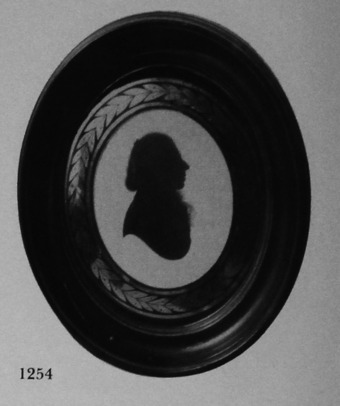
General Tarleton
Silhouette painted on plaster
c. 1786-88
3 ½ x 2 ½ in./90 x 64mm.
Trade Label
Frame: oval, pearwood, with verre églomisé border
Painted at 4 Brunswick Street, Edinburgh. The sitter was probably General Banastre Tarleton (1754-1833), British cavalry commander in the War of American Independence.
J. A. Pollak collection
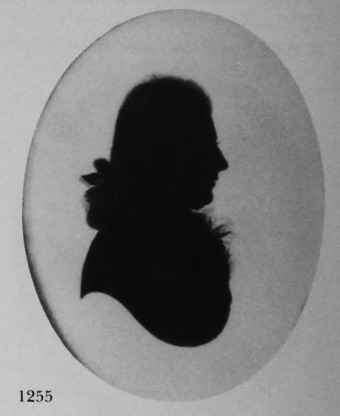
‘– Dale, Esw.’
Silhouette painted on plaster
1780s
3 ¾ x 3in./96 x 77mm.
Trade Label
Frame: oval, pearwood, with gilded inner edge
The date is suggested by the sitter’s wig, in fashion during the 1780s. his initial has been obliterated from the inscription.
R. Kilner collection
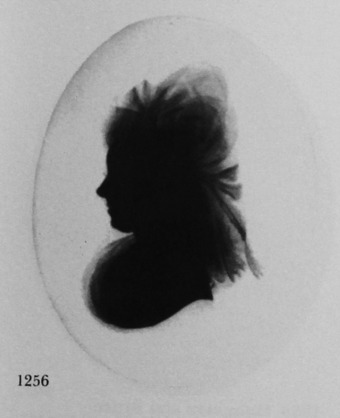
Unknown woman
Silhouette on plaster 1787-90
3 ½ x 2 ½ in./90 x 64mm.
Trade Label
Frame: oval, pearwood
D. S. Patton collection

Frances Yate
Silhouette painted on plaster
c. 1788-90
3 ½ x 2 ½ in./90 x 64mm.
Trade label
Frame: oval, pearwood, with gilded inner edge
Author’s collection

Unknown girl
Silhouette painted on plaster
c. 1788-91
3 ½ x 2 ½ in./90 x 64mm.
Trade Label
Frame: oval, pearwood, with verre églomisé border
M. A. H. Christie collection
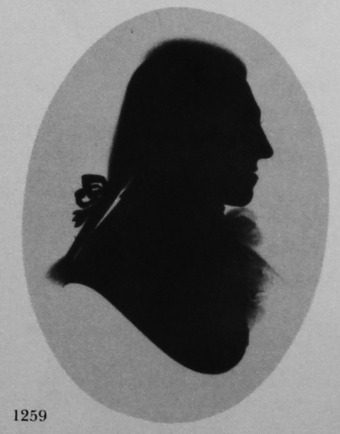
Mr Ronald
Silhouette painted on plaster
c. 1790
3 ½ x 2 ½ in./90 x 64mm.
Trade label
Frame: oval, pearwood, with verre églomisé border
Author’s collection

Master Hugh Maclean
Silhouette painted on plaster
c. 1790
3 ½ x 2 ½ in./90 x 64mm.
Trade label
Frame: oval, hammered brass
See 1399 for a silhouette of the sitter’s mother by John Smith.
From the collection of the late J. C. Woodiwiss
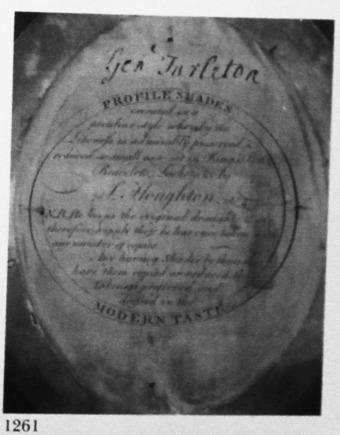
Trade label of Samuel Houghton, from the reverse of the silhouette illustrated in 1254.
J. A. Pollak collection
Detail

Hair and ribbons. Detail from a silhouette of a woman by Samuel Houghton. Note the well defined dark brush-strokes, ending well before the finish of the curls (which are terminated more indefinitely than curls painted by John Miers). (1257)

Pigtail wig. Detail from a silhouette of a man by S. Houghton, bearing the label of Houghton and Bruce. (1263)
Crown Copyright. Victoria and Albert Museum, No. P39 1927

Shirt-frill. Detail from a silhouette of a man by S. Houghton, showing a lack of finish in comparison with John Miers’s later work. (1259)

Frill on a girl’s dress. This detail from a silhouette by Samuel Houghton shows the artist at his best, although his work is less finished than that of John Miers during his later period. (1258)
M. A. H. Christie collection
